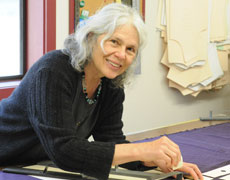The future of fabric? Think circular.
Posted by Rose on 20th Sep 2022
A recent expo in London promises a world in which eco-friendly clothing will be plastic-free and entirely recyclable.

The Ramie Scarf/Wrap is made from nettles and is hand-dyed using indigo and low impact dyes.
Last June the 10th Future Fabrics Expo held in London pulled back the curtains on a range of exciting fabrics that offer earth-friendly alternatives to some of the most polluting textiles and fabric processing practices. While there were displays presenting the latest recycling technologies to minimize petrochemical use, the expo’s overarching reality was the idea that long-term sustainability depends on circular systems. These systems must take into account the entire life cycle of fibers from their manufacturing or, in the case of natural fibers, their cultivation, all the way through manufacturing, special treatments, and recycling that enables textile-to-textile transformation of post-consumer fibers into new fabrics.
As detailed in an Innovation in Textiles article, this kind of recycling will require further development of new techniques for collecting and sorting textiles bound for recycling as well as chemical and mechanical separation technologies that ready recycled fibers to take on a brand-new life. As noted at the expo, a lot of money is being invested in these systems. Despite that, Cyndi Rhoades of Worn Again Technologies says this is a long-term effort; she doesn’t see synthetic and blended textile-to-textile fibers replacing virgin fabrics for at least another 20 to 30 years.
One of the most promising developments recounted in the Innovation in Textiles story is the realization that we can create a more diverse repertoire of natural materials to work with. Working with plant and animal fibers such as linen, hemp, ramie, yak and alpaca as well as classic textiles like wool, silk, cashmere, and cotton will help support biodiversity. As an example, the company that manufactures the three-dimensional pile fabrics used on famous Steiff stuffed toys uses an array of natural fibers to create unique textures. These include hemp, bamboo, cotton, and linen.
A substantial part of the expo was devoted to biologically safe fabric dyes and finishes suitable for eco-friendly clothing Algae and other microorganisms are being used to produce pigments and wicking finishes on sportswear. New dyestuffs are also being developed from agricultural and food-processing waste. A dyeing machine that uses bacteria to apply patterns and graphic designs directly onto fiber is also in the works.
What separates many of these technologies from more pie-in-the-sky efforts is the pragmatism that informs them. The developers of these new technologies recognize that they have to work at scale and have to economically compete against conventionally made textiles. But as the true costs of plastic clothing come into sharper focus, the economic advantages of genuinely sustainable textiles will help edge out petrochemicals.
Share:





